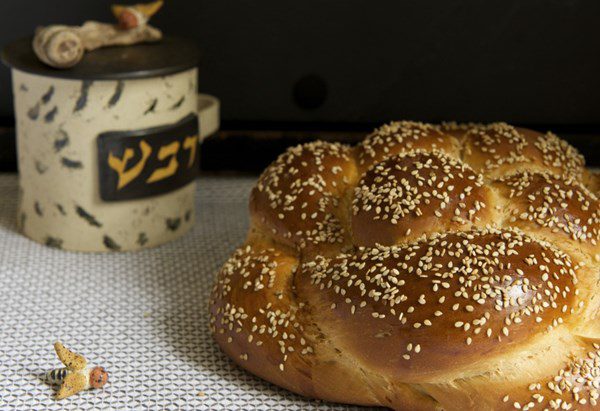The foods of Rosh Hashanah
September 15, 2023 by DarcieRosh Hashanah, meaning “head of the year” in Hebrew, is the celebration of the Jewish New Year. The holiday includes several food-related customs including eating apples dipped in honey, as well as eating other symbolic foods such as pomegranates, dates, string beans, beets, pumpkins, leeks, and fish heads. Each of these symbolizes a wish or blessing for prosperity and health in the coming year.

In addition to these symbolic foods, Rosh Hashanah feasts includes classic Jewish dishes, many of them on the sweet side, in the hopes of a sweet year to come. The EYB Library is a terrific resource to help plan a celebration of the Jewish New Year. It contains plenty of side dishes and desserts listed under Other Jewish Holidays, and you can search the database to find more recipes for Rosh Hashanah foods and ingredients:
- Challah – This rich yeasted bread is often baked in a rounded or spiral shape, which symbolizes continuity.
- Gefilte fish – Gefilte translates as “stuffed” in Yiddish, a reflection of the original preparation of stuffing the ground seasoned fish back into the skin of the fish. Over the centuries this practice has mostly been abandoned, and the fish mixture is either shaped into individual patties or baked as a single loaf.
- Brisket – Cooking brisket began as a way to make the most from an economical cut, and boy do these recipes succeed in that regard. Today brisket is so well-loved that it is no longer considered a bargain cut.
- Tzimmes – Tzimmes is generally understood as Yiddish for “a big fuss,” although the dish called tzimmes is usually a simple stew made with sweet root vegetables. There are dozens of variations on this savory/sweet side dish. Carrots and honey are the standard, but you might also see sweet potato, apricots, prunes, and apples included.
- Kugel – Kugel is a generic term for pudding and can take several forms as well, with noodle kugel and potato kugel both popular choices. Because noodle kugel is sweet, it often ends up on Rosh Hashanah tables.
- Honey cake – Considered by some to be the fruitcake of the kosher kitchen (with all the baggage that implies), honey cake is still a popular food served during the Jewish New Year.
- Pomegranates – this fruit is steeped with symbolic meaning. Considered a “new fruit” (fruits that have not been eaten in a long time), they are often eaten on the second night of Rosh Hashanah. Pomegranates are also (apocryphally) said to have exactly 613 seeds, connecting it to the 613 commandments of the Torah.
- Dates – The Hebrew word for dates, t’marim, evokes the word tam, “to end.” By eating dates, the hope is that one’s enemies will be finished.
- Beets – Along the same lines, the Hebrew word for beets, selek, is similar to the word for “remove.” Beets are eaten to express the hope that one’s enemies will depart.
- Leeks – Another word association is at play here. In this case, the word for leek is related to a word that means cut off or destroy. The prayer is that any enemies will be destroyed.
Categories
- All Posts (6940)
- Antipasto (2135)
- Author Articles (247)
- Book News (935)
- Cookbook Giveaways (983)
- Cookbook Lovers (257)
- Cooking Tips (109)
- Culinary News (299)
- Food Biz People (552)
- Food Online (791)
- Holidays & Celebrations (272)
- New Cookbooks (149)
- Recipes (1500)
- Shelf Life With Susie (231)
- What's New on EYB (133)
Archives
Latest Comments
- Atroyer7 on Danube Cookbook Review and Giveaway
- demomcook on What foods do you look forward to the most for each season?
- demomcook on Danube Cookbook Review and Giveaway
- Darcie on How cookbooks can help build resilience
- mholson3 on Danube Cookbook Review and Giveaway
- Rinshin on How cookbooks can help build resilience
- sarahawker on Danube Cookbook Review and Giveaway
- Sand9 on Danube Cookbook Review and Giveaway
- hankintoby29 on Heritage Cookies of the Mediterranean World – Cookbook Giveaway
- WBB613 on Feasts of Good Fortune Cookbook Giveaway